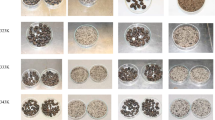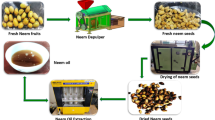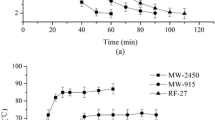Abstract
Instant controlled pressure drop process (DIC) was used to texture rapeseeds in order to intensify oil extraction performances of both pressing and solvent extraction processes. Solvent extraction from both DIC-textured and non-treated raw material RM seeds was achieved with n-hexane using separately accelerated solvent extraction (ASE) and dynamic maceration (DM). ASE allowed quantifying the extraction yields while the extraction kinetics issued from DM experimental data was studied through coupled washing/diffusion CWD phenomenological model. ASE oil contents were 622.5 ± 0.5 and 664.4 ± 0.5 g oil/kg dry dry basis ddb for untreated and DIC-textured seeds, respectively. In terms of kinetics, 45-min DM of DIC-treated seeds implied higher yields than 8-h DM of RM (467.8 ± 0.5 against 435.6 ± 0.5 g oil/kg ddb). Moreover, pressing oil yields reached 553.5 ± 0.5 against 490 ± 0.5 g oil/kg ddb for DIC and RM seeds, respectively. Besides, optimized DIC treatment allowed obtaining preservation of lipid fatty acid profiles.





Similar content being viewed by others
References
Aider, M., & Barbana, C. (2011). Canola proteins: composition, extraction, functional properties, bioactivity, applications as a food ingredient and allergenicity—a practical and critical review. Trends in Food Science & Technology, 22(1), 21–39.
Allaf K. (2009). The new instant controlled pressure—drop DIC technology. In: Essential oils and aromas: green extraction and application. Chemat F: New Delhi, pp 85–121.
Allaf, T. (2014). Intermitent extraction process via solvent (DIC-TriPolium). International demand PCT/FR2015/051123; priority date: 25/04/2014 (France Patent); International classification and CIB: INV.B01d11/02.
Allaf, K., Besombes, C., Berka-Zougali, B., Kristiawan, M., Sobolik, V., & Allaf, T. (2011). Instant controlled pressure drop technology in plant extraction processes. In N. Lebovka, E. Vorobiev, & F. Chemat (Eds.), Enhancing extraction processes in the food industry. Contemporary food engineering series (pp. 255–302). Dublin: CRC Press Taylor & Francis Group.
Allaf, T., Mounir, S., Tomao, V., & Chemat, F. (2012). Instant controlled pressure drop combined to ultrasounds as innovative extraction process combination: fundamental aspects. Procedia Engineering, 42, 1061–1078.
Allaf, T., Fine, F., Tomao, V., Nguyen, C., Ginies, C., & Chemat, F. (2014a). Impact of instant controlled pressure drop pre-treatment on solvent extraction of edible oil from rapeseed seeds. OCL, 21(3), A301.
Allaf, T., Zougali, B., Nguyen, C., Negm, M., & Allaf, K. (2014b). DIC texturing for solvent extraction. In T. Allaf & K. Allaf (Eds.), Instant controlled pressure drop (D.I.C.) in food processing. Food engineering series (pp. 127–149). New York: Springer.
Amor, B. B., Lamy, C., Andre, P., & Allaf, K. (2008). Effect of instant controlled pressure drop treatments on the oligosaccharides extractability and microstructure of Tephrosia purpurea seeds. Journal of Chromatography A, 1213(2), 118–124.
Azadmard-Damirchi, S., Habibi-Nodeh, F., Hesari, J., Nemati, M., & Achachlouei, B. F. (2010). Effect of pretreatment with microwaves on oxidative stability and nutraceuticals content of oil from rapeseed. Food Chemistry, 121(4), 1211–1215.
Ben Amor, B. (2008). Maîtrise de l’aptitude technologique de la matière végétale dans les opérations d’extraction de principes actifs: texturation par détente instantanée contrôlée (DIC). La Rochelle.
Ben Amor, B., & Allaf, K. (2009). Impact of texturing using instant pressure drop treatment prior to solvent extraction of anthocyanins from Malaysian Roselle (Hibiscus sabdariffa). Food Chemistry, 115(3), 820–825.
Besombes, C., Berka-Zougali, B., & Allaf, K. (2010). Instant controlled pressure drop extraction of lavandin essential oils: fundamentals and experimental studies. Journal of Chromatography A, 1217(44), 6807–6815.
Bouallegue, K., Allaf, T., Besombes, C., Younes, R. B., & Allaf, K. (2015). Phenomenological modeling and intensification of texturing/grinding-assisted solvent oil extraction; case of date seeds (Phoenix Dactylifera L.). Arabian Journal of Chemistry. doi:10.1016/j.arabjc.2015.03.014.
Boutin, O., & Badens, E. (2009). Extraction from oleaginous seeds using supercritical CO2: experimental design and products quality. Journal of Food Engineering, 92(4), 396–402.
El Kadi, I. (2012). Contribution à l’amélioration de l’utilisation alimentaire du tourteau de canola: Décoloration par du peroxyde d’hydrogène et impact sur le produit. Université Laval.
Fernández, M. B., Perez, E. E., Crapiste, G. H., & Nolasco, S. M. (2012). Kinetic study of canola oil and tocopherol extraction: parameter comparison of nonlinear models. Journal of Food Engineering, 111(4), 682–689.
Kraujalis, P., Venskutonis, P. R., Pukalskas, A., & Kazernavičiūtė, R. (2013). Accelerated solvent extraction of lipids from Amaranthus spp. seeds and characterization of their composition. LWT - Food Science and Technology, 54(2), 528–534.
Kristiawan, M., Sobolik, V., Klíma, L., & Allaf, K. (2011). Effect of expansion by instantaneous controlled pressure drop on dielectric properties of fruits and vegetables. Journal of Food Engineering, 102(4), 361–368.
Lacki, K., & Duvnjak, Z. (1998). Decrease of phenolic content in canola meal using a polyphenol oxidase preparation from trametes versicolor: effect of meal saccharification. Biotechnology Techniques, 12(1), 31–34.
Lomascolo, A., Uzan-Boukhris, E., Sigoillot, J.-C., & Fine, F. (2012). Rapeseed and sunflower meal: a review on biotechnology status and challenges. Applied Microbiology and Biotechnology, 95(5), 1105–1114.
Meziane, S., & Kadi, H. (2008). Kinetics and thermodynamics of oil extraction from olive cake. Journal of the American Oil Chemists’ Society, 85(4), 391–396.
Mounir, S., & Allaf, K. (2008). Three-stage spray drying: new process involving instant controlled pressure drop. Drying Technology, 26(4), 452–463.
Newkirk, R. W., Classen, H. L., & Edney, M. J. (2003). Effects of prepress-solvent extraction on the nutritional value of canola meal for broiler chickens. Animal Feed Science and Technology, 104(1–4), 111–119.
Niu, C. H., Baylak, T., Wilson, D. I., & Zhang, M. (2014). Pelletisation of canola meal by extrusion–spheronisation for ethanol dehydration. Biomass and Bioenergy, 66, 116–125.
Oyinlola, A., Ojo, A., & Adekoya, L. O. (2004). Development of a laboratory model screw press for peanut oil expression. Journal of Food Engineering, 64(2), 221–227.
Prakash, A. & Stigler, M. (2012). FAO statistical yearbook. Food and Agriculture Organization of The United Nations In. p^pp.
Simopoulos, A. P., Leaf, A., & Salem, N., Jr. (2000). Workshop statement on the essentiality of and recommended dietary intakes for omega-6 and omega-3 fatty acids. Prostaglandins, Leukotrienes and Essential Fatty Acids (PLEFA), 63(3), 119–121.
So, G. C., & MacDonald, D. G. (1986). Kinetics of oil extraction from canola (rapeseed). The Canadian Journal of Chemical Engineering, 64(1), 80–86.
Teh, S.-S., & Birch, J. (2013). Physicochemical and quality characteristics of cold-pressed hemp, flax and canola seed oils. Journal of Food Composition and Analysis, 30(1), 26–31.
Ucar, S., & Ozkan, A. R. (2008). Characterization of products from the pyrolysis of rapeseed oil cake. Bioresource Technology, 99(18), 8771–8776.
Van, C. N. (2010) Maîtrise de l’aptitude technologique des oléagineux par modification structurelle: applications aux opérations d’extraction et de transestérification in-situ. Université de La Rochelle
Wang, W.-C., Turner, T. L., Stikeleather, L. F., & Roberts, W. L. (2012). Exploration of process parameters for continuous hydrolysis of canola oil, camelina oil and algal oil. Chemical Engineering and Processing Process Intensification, 57–58, 51–58.
Author information
Authors and Affiliations
Corresponding author
Rights and permissions
About this article
Cite this article
Bouallegue, K., Allaf, T., Ben Younes, R. et al. Texturing and Instant Cooling of Rapeseed as Pretreatment Prior to Pressing and Solvent Extraction of Oil. Food Bioprocess Technol 9, 1521–1534 (2016). https://doi.org/10.1007/s11947-016-1734-x
Received:
Accepted:
Published:
Issue Date:
DOI: https://doi.org/10.1007/s11947-016-1734-x




